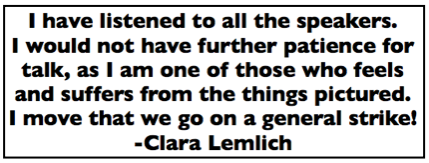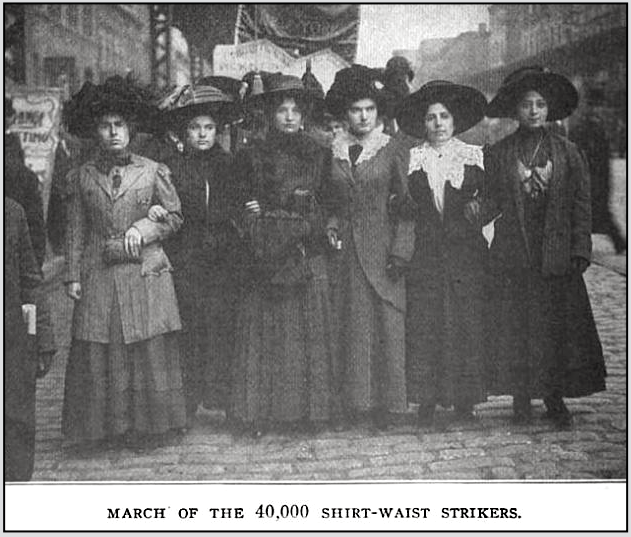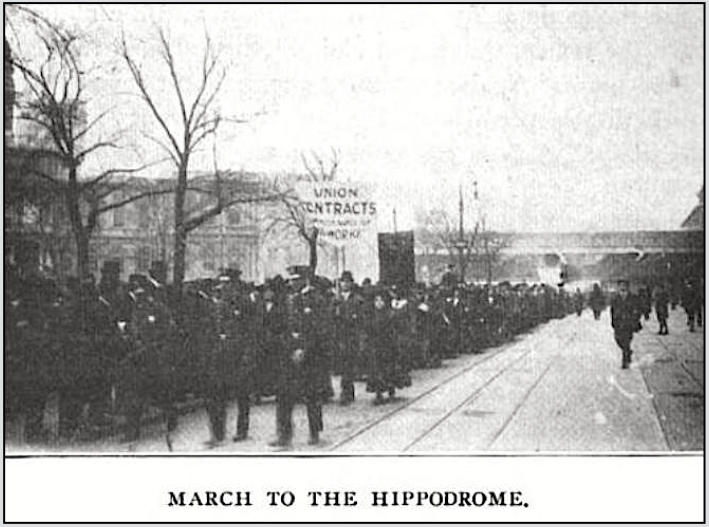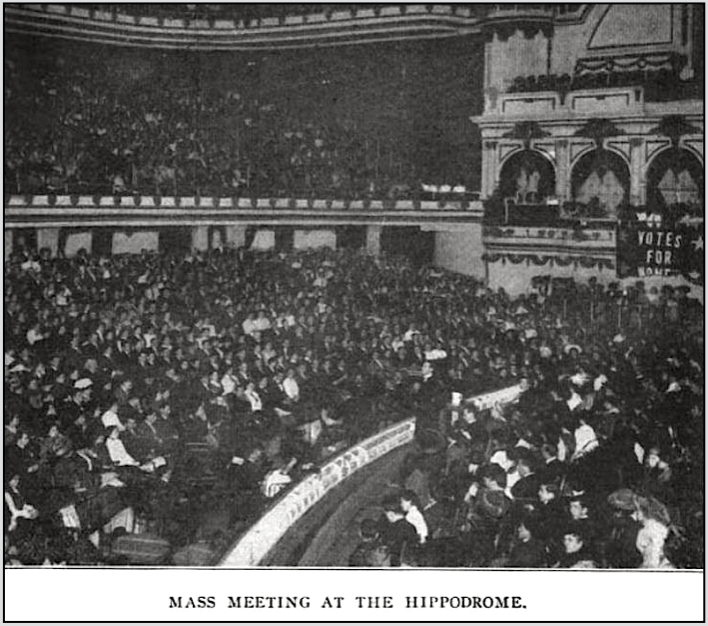 ———-
———-
Hellraisers Journal – Thursday January 13, 1910
Rose Strunsky on New York City’s Shirtwaist Uprising, Part II
From the International Socialist Review of January 1910:
The Strike of the Singers of the Shirt
—–By Rose Strunsky.
—–[Part II of II.]
The next day [November 24th, following the November 23rd mass meeting at Cooper Union], when the girls in the shops were informed of the general strike, they rose without a question, left their work and went out. Six hundred shops joined the union in a few days. The spontaneous and enthusiastic response to the call came as a great surprise to every one. None had guessed of this latent fire-neither the leaders, nor the Woman’s Trade Union League, nor the girls themselves. None knew that it was there. In forty-eight hours it reached forty thousand girls. Their demands were for the recognition of the union, a twenty per cent, increase in their wages and shorter hours—a fifty-two hour working week.
Before the strike was several hours old twenty shops settled and five hundred girls won. The next day forty-one shops settled and seven thousand girls returned to work and each day brings bosses who are willing to settle on union terms.
Morning, afternoon and evening every hall on the East Side and the large halls in the city that could be gotten, were filled with strikers and sympathizers, to discuss ways and means and to encourage each other in the struggle.
The war was on, and the chivalrous instincts in the old veterans of the class struggle came out. Besides the Socialists and the Women’s Trade Union League, the United Hebrew Workers [United Hebrew Trades] sent out committees to help these new militants; the American Federation of Labor offered Mr. Mitchell to give his aid and advice, and Solomon Shindler [Schindler], the Gompers of the East Side, has directed their forces from the very beginning.
It is hard to tell here if it would not have been better to have shown less chivalry and to have let this new army fight its own battle. It is a question in some minds whether the fact that the girls were permitted to sign up with their bosses, while the other three-fourths of their comrades were still on strike, was good tactics for the girls who have returned to work are forced, perhaps, to scab on their sisters by doing the work of the manufacturers who are still on strike.
Yet this is the time-honored method in strikes and can be used to advantage in a long strike as in the case of the strike now on in Sweden, where more than half the workers were permitted to go back to work by the unions so as to support the other half in their fight with the bosses. Moreover, in the shirtwaist making industry, each shop has its own kind of work and therefore there can be no uniform price. Since each shop has to be settled with differently, it is almost impossible to keep the general strike in force.
If labor is showing its solidarity, so is capital protecting its interests. A shirt-waist manufacturers’ association has already been formed and it threatens to be obstinate and obdurate. Mr. Mitchell and Mr. Hymans, of the National Association of Clothiers, have suggested arbitration. They proposed that two men be elected by the strikers and two by the shirt waist manufacturers, who in turn are to elect two others; and that this committee of six should arbitrate. But the one thing they were firm about was that the strikers would listen to no arbitration if the union were not to be recognized. So far the Shirt-Waist Makers’ Association has not responded to this letter although the strikers have elected their two men, who are Mitchell and Hillquit.*
The first hours of success are now followed by long days of obdurate waiting and fighting. Of course the whole industry is not called out and the manufacturers are sending their goods to be finished in neighboring cities. Still there is no doubt that, with the aid of the great sympathy which the girls have won for themselves among the whole population, they would be victorious in the long run did they have the wherewithal to carry on this fight. Most of them have families to support and two weeks of strike leaves them penniless. The strike committee has already had to buy bread for many of them. Were the union older, or could they expect much support from other unions, their victory would be certain. As it is, seventeen thousand girls were victorious, as to the twenty-three thousand who are out on strike, we must hope for the best.
A strike is as sexless as a factory, and the laws for the Singers of the Shirt are the same as for the longshoreman and the miner. The employers have the police, thugs and plain-clothes men, the judges and the courts to help them. Against all these the girls pit themselves. Though peaceful picketing is permissible by law, about twenty-five or fifty girls are arrested daily. A boss can point out any one as a striker or charge her with calling “scab,” and she is immediately arrested, and roughly handled; then fined by the judge. In the beginning of the strike the fines were from two to three dollars. They are now from five to ten dollars, or three hundred dollars’ bail, to keep the peace for three months—which defined, means no picketing at all.
Moreover, we are beginning to hear threats of the workhouse from these worthy dispensers of the law, and several have already been sentenced. “You girls are getting to be a nuisance and a menace to the community,” said Magistrate Krotel, of the Essex Market Court, “and I am here to do all in my power to stop this disorder. You are acting inexcusably in attacking the policemen (sic!) and the next time you are brought here, I will send you to the workhouse.” This conception of order is equal to the Cossacks, which is the order that comes after the healthful use of the knout.
The “Uptown scum” (the proud title which the Woman’s Trade Union League has won for itself by its activities among the working women) decided to march with the girls, on December 2nd [3rd], to the Mayor of this city, to inform him of their legal right to picket and to tell him that when they are arrested they are mishandled and often beaten and that the police permit the hired thugs of the employers to assault them without offering protection. Ten thousand girls marched with this delegation through the streets of New York. The sight of these dignified, earnest and intense strikers was inspiring and soul-stirring. Even the Mayor was impressed. He received the committee, he heard their complaint, was astonished at the facts related, which up to now, in the stress of his work, had escaped his notice, and promised to investigate. But over a week has passed, and the fines still go on depleting the precious treasury of the union, which ought to go for bread for the strikers, and it is easily imagined that the treatment of the combined force of unrestrained thugs, Pinkertons and police is not gentle.
If public opinion alone could win a strike, this one would surely be won, for the dramatic qualities and beauty of this first battle of women workers has not failed to escape every class except those who are financially interested in their defeat. The woman’s suffrage movement seems to be eager to help them (though it doesn’t forget to help itself in the meantime), and Mrs. Belmont, on December 5th, hired the Hippodrome, the largest theatre in the city of New York, for the purpose of having the story of the strikers told and spreading sympathy for them among all classes and to teach them women’s suffrage. Mrs. Rose Pastor Stokes and Leonora O’Reilly represented the Socialist and union point of view, and Dr. Anna H. Shaw spoke as a woman suffragist, with the cause of the working girls in her heart. The Colony Club, that most exclusive and fashionable women’s club in the city, with Mrs. Egerton Winthrop and Miss Anne Morgan as hostesses, has invited these girls, for the purpose of hearing their story and spreading it to the public.
The fight is alive and keen. There is no quiet sitting down and waiting for results. Not a day passes without some spectacular effect, some fight brilliantly managed; some meeting where enthusiasm is roused and courage strengthened.
Here lies the special interest of this strike. It is the psychology which is displayed in it that is more wonderful than the facts themselves, coldly described. We cannot measure such movements by net results, and the strike will be a success even if it fails; it will be a successful failure. The girls have won for themselves the knowledge of united strength, the consciousness of their united power, and the realization that when the Song of the Shirt is sung in chorus, they drop forever the time-worn slavery of the woman sitting alone with “fingers weary and worn,” plying her needle from sunrise to midnight, but that they have their place with their brothers in the fight of Labor. They become comrades and equals on this battlefield.
And so much we know today: That seventeen thousand women have bettered their conditions and that the spirit of solidarity has entered the hearts of forty thousand Singers of the Shirt.
*The latest report is that the shirt-waist manufacturers have appointed their two men, T. H. Hyman and H. T. Callahan and that after a three hours’ conference with Mitchell and Hillquit have come to a deadlock. The manufacturers refuse to recognize the union and insist on an open shop, though they are willing to grant increase in wages and shorter hours. The representatives of labor refuse to arbitrate in any other way than on a union basis. It is reported that the manufacturers have decided to give new instructions to their representatives.—December 11.
———-
Note: emphasis added throughout.
~~~~~~~~~~~~~~~~~~~~~~
SOURCES & IMAGES
Quote Clara Lemlich at Cooper Un Nov 22, NY Call p2, Nov 23, 1909
https://www.marxists.org/history/usa/pubs/the-new-york-call/1909/091123-newyorkcall-v02n287.pdf
The International Socialist Review, Volume 10
(Chicago, Illinois)
-July 1909-June 1910
C. H. Kerr & Company, 1910
https://books.google.com/books?id=MVhIAAAAYAAJ
ISR – Jan 1910
https://play.google.com/books/reader?id=MVhIAAAAYAAJ&printsec=frontcover&pg=GBS.PA577
“Strike of the Singers of the Shirt” by Rose Strunsky
https://play.google.com/books/reader?id=MVhIAAAAYAAJ&printsec=frontcover&pg=GBS.PA620
Part II
https://play.google.com/books/reader?id=MVhIAAAAYAAJ&printsec=frontcover&pg=GBS.PA620&pg=GBS.PA623
See also:
Hellraisers Journal – Tuesday January 11, 1910
“The Strike of the Singers of the Shirt” by Rose Strunsky for International Socialist Review, Part I
Hellraisers Journal – Wednesday January 12, 1910
From a 19th Century Song Sheet: “The Song of the Shirt” by Thomas Hood
Tag: NYC Waistmakers Uprising of 1909-1910
https://weneverforget.org/tag/nyc-waistmakers-uprising-of-1909-1910/
Re United Hebrew Trades & ILGWU Strike of 1909, see:
The 1909 ILGWU strike established a precedent for serious collective action in other branches of the garment economy BY HOWARD SACHAR
The largest of the shirtwaist factories belonged to the Triangle and Leiserson companies, both German‑Jewish. Earlier attempts to unionize the two firms had failed. Then, in September 1909, workers at the Triangle plant voted to bypass the company‑sponsored “benevolent association” in favor of the United Hebrew Trades, the consciousness-raising organizers of Jewish‑staffed industry. Hereupon, Triangle’s management fired the “troublemakers” and advertised for replacements. In turn, Local 25 of the ILGWU called for a strike.
Re John Mitchell (of UMWA) and Morris Hillquit (of SPA), negotiators, see:
https://jwa.org/encyclopedia/article/uprising-of-20000-1909
For much of the eleven-week strike, workers and manufacturers were locked in a stalemate. The Associated Waist and Dress Manufacturers, representing the large employers, rejected the closed union shop. Exhausted, but determined, workers refused to budge on this point, fearing that an open shop would leave the union powerless to enforce agreements. However, the strikers (represented at the negotiating table by Socialist Party leader Morris Hillquit and John Mitchell of the United Mine Workers) could not hold out. The general strike was called off unceremoniously on February 15, 1910, with about a thousand workers still on the picket line.
According to this source, Solomon Schindler was Protocol Secretary of UHT:
The Jewish Unions in America
Pages of History and Memories
-by Bernard Weinstein
Open Book Publishers, Feb 6, 2018
(search: “solomon schindler”)
https://books.google.com/books?id=0ndKDwAAQBAJ
Swedish General Strike of 1909
https://libcom.org/history/1909-swedish-general-strike
Re proud title: “uptown scum”, see:
Triangle
The Fire that Changed America
-by David Von Drehle
Grove Press, 2004
(search: “uptown scum”)
https://books.google.com/books?id=Xw4fjRQFusQC
Another day [during November of 1909], Helen Marot, a WTUL executive, showed up to observe the picket line. A policeman growled at her: “You uptown scum! Keep out of this, or you’ll find yourself in jail.”
Helen Marot
https://en.wikipedia.org/wiki/Helen_Marot
Rose Pastor Stokes
https://jwa.org/encyclopedia/article/stokes-rose-pastor
Leonora O’Reilly
https://spartacus-educational.com/USAWoreilly.htm
Anna Howard Shaw
https://en.wikipedia.org/wiki/Anna_Howard_Shaw
Re Colony Club-Mrs. Belmont, Miss Morgan, Mrs. Winthrop-& Shirtwaist Strike, see:
What Eight Million Women Want
-by Rheta Childe Dorr
Small, Maynard & Company, 1910
https://books.google.com/books?id=t4cEAAAAYAAJ
-page 173
https://play.google.com/books/reader?id=t4cEAAAAYAAJ&hl=en&pg=GBS.PA173
Re Anne Morgan, etc, as “mink brigade”, see:
The Diary of a Shirtwaist Striker
-by Theresa Serber Malkiel
Cornell University Press, 1990
-with essay by Francoise Basch
(search: “mink brigade”)
https://books.google.com/books?id=uda30NF0MD8C
From Kheel Center
https://www.flickr.com/photos/kheelcenter/5279773582/
Six women including Mary Dreier, Ida Rauh, Helen Marot, Rena Borky, Yetta Raff, and Mary Effers linked arm in arm in their march to City Hall during the shirtwaist strike to demand an end to abuse by police . Other shirtwaist strikers follow behind carry
Title: Six women including Mary Dreier, Ida Rauh, Helen Marot, Rena Borky, Yetta Raff, and Mary Effers linked arm in arm in their march to City Hall during the shirtwaist strike to demand an end to abuse by police . Other shirtwaist strikers follow behind carrying a union banner, Dec. 3, 1909.
New York Call of Dec 4, 1909 re Dec 3rd March to City Hall
https://www.marxists.org/history/usa/pubs/the-new-york-call/1909/091204-newyorkcall-v02n298.pdf
~~~~~~~~~~~~~~~~~~~~~~~~~~~~~~~~~~~~~~~~~~~~~
Bread and Roses – Judy Collins



